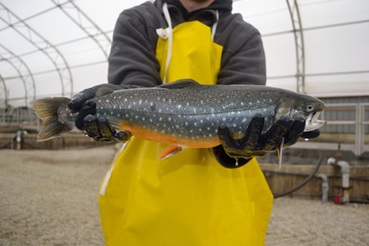Arctic char
Introduction
Arctic char (Salvelinus alpinus) is native to circumpolar regions of the Northern hemisphere in North America, Europe and Asia, having the most northerly distribution of any freshwater fish. Char inhabits both fresh and saltwater bodies, including inshore marine environments and freshwater rivers and lakes.
In Canada, the development of Arctic char (Figure 1) as an aquaculture species began in the early 1980s with wild gamete collections on the Fraser River (Labrador), Tree River (Nunavut) and Nauyuk Lake (Nunavut) conducted by Fisheries and Oceans Canada Offspring from these wild egg collections have formed what is now the genetic basis of domestic Arctic char breeding populations in Canada that are widely used in the aquaculture industry.

In Canada, Arctic char aquaculture occurs in the Yukon, Manitoba, Ontario, Quebec, New Brunswick, Nova Scotia and Newfoundland. The Monterey Bay Aquarium’s Seafood Watch program has recommended all Arctic char produced in Canada using land-based flow-through and recirculating aquaculture systems to be an ecologically sustainable product and a “best choice” for consumers, as the production of the species represents a low risk of environmental impact.
Ontario arctic char aquaculture
Arctic char aquaculture in Ontario started in 1989 when genetic stock from the Fraser River (Labrador) strain were imported to the Ontario Aquaculture Research Centre in Alma, Ontario. Arctic char aquaculture in Ontario occurs exclusively in land‑based production systems using freshwater. While currently a small industry, production of the species has grown in recent years to include three Ontario farms.
Notably, char is considered a high-value unique species with limited supply and typically demands a higher wholesale price relative to other salmonids. With an abundance of cold freshwater resources, the province of Ontario is a strong candidate for Arctic char aquaculture. Char is a cold‑water-tolerant species able to feed at temperatures close to zero that achieves maximum growth between 12°C to 15°C. The species prefers high stocking densities, between 60 to 90 kg/m3 to optimize economic productivity, and can be cultured at a stocking density of up to 150 kg/m3 under optimal water quality and rearing conditions without negative welfare implications. While char can survive short-term exposures to low dissolved oxygen concentrations, it is recommended to maintain oxygen saturation between 80% to 100% for optimal fish health and productivity
Farming conditions for arctic char
In aquaculture, Arctic char exhibit variable growth rates within the population where producers benefit from regular size grading to optimize feeding and growth. In Ontario, harvesting begins when the largest fish in the population reach 1 kg in body size. Top-grading (removing the largest fish) bi‑weekly for harvest allows the smaller fish in the population to grow and reach market size. When cultured under typical Ontario conditions, Arctic char will reach sexual maturation at 3 years of age. Due to decreased flesh quality associated with reproduction, char should be harvested before reaching this stage.
One major challenge with char production is egg survival, as char exhibit poor adaptability to warm water temperature during incubation, resulting in poor egg quality and reduced hatching success. After hatch, studies have shown that when juvenile Arctic char are exposed to a 24-hour continuous photoperiod and 24-hour continuous feed availability, the species will have improved growth rates and lower cumulative mortality
Once in the grow-out phase, char do well in natural Ontario groundwater (8.5°C to 9.0°C) and can surpass typical rearing densities for other salmonids. Another challenge for char producers in Ontario is their susceptibility to bacterial diseases when they are nearing their reproductive cycle. For this reason, it is recommended to rear char using groundwater or in land-based recirculating aquaculture systems where pathogen loads are lower and biosecurity practices can be enforced.
Species outlook
Arctic char is a unique aquaculture species that performs well under intensive aquaculture conditions and in cold freshwater environments making them well suited for aquaculture in Ontario. The species presents an opportunity to diversify Ontario’s aquaculture sector and meet market demands into the future.
References
Burke, M.G., Kirk, M.R., MacBeth, N.A., Bevan, D.J., and Moccia, R.D. 2005. Influence of Photoperiod and Feed Delivery on Growth and Survival of First-Feeding Arctic Char. North American Journal of Aquaculture. 67(4):344‑350.
Ethier, V. 2014. Farmed Arctic Char Salvelinus alpinus — Canada, Iceland, U.S.: Land-based flow-through and recirculating aquaculture systems. Monterey Bay Aquarium Seafood Watch.
Larsson, S., and Berglund, I. 1998. Growth and food consumption of 0+ Arctic char fed palletized and natural food at six different temperatures. Journal of Fish Biology 52:230-242.
National Farm Animal Care Council (NFACC). 2020. Draft Code of Practice for the Care and Handling of Farmed Salmonids.
Scott, W.B., and Crossman, E.J. 1973. Freshwater fishes of Canada. Fisheries Research Board of Canada. 184:1-190.
Sevier, A., Smith, R., Benfey, T., Danzmann, R., Bernier, N., and Moccia, R. 2019. Effects of biodensity on the growth, stress physiology and welfare of Arctic char (Salvelinus alpinus) in freshwater. Comparative Biochemistry and Physiology, Part A. 231:91–103.
Summerfelt, S.T., Wilton, G., Roberts, D., Rimmer, T., and Fonkalsrud, K. 2004. Developments in recirculating systems for Arctic char culture in North America. Aquacultural Engineering. 30(1-2):31-71.
Yossa, R., Bardon-Albaret, A., Chiasson, M.A., Liu, Q., Duston, J., Manning, T., and Benfey, T.J. 2019. Controlling preharvest maturity in farmed Arctic char: A review from the Canadian perspective. 50:894-907. DOI: 10.1111/jwas.12622.
Author credits
This fact sheet was written by Madeline Borland, MSc., aquaculture literature research Assistant, and reviewed by Michael McQuire, aquaculture and aquaponics specialist, Ontario Ministry of Agriculture, Food and Rural Affairs (OMAFRA). Special thanks to Marcia Chiasson, manager of the Ontario Aquaculture Research Centre, Alma, Ontario for her contributions.
ISSN 1198-712X, Published December 2023.